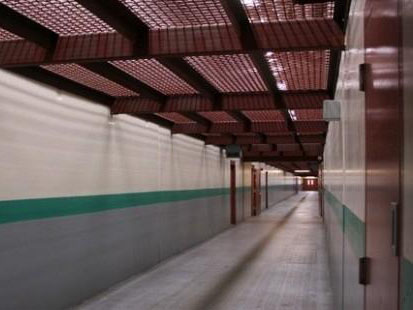The US state of California must make substantial changes to their prison isolation units and halt the inhuman suffering of thousands of prisoners, Amnesty International said in a new report out today.
The Edge of Endurance: Conditions in California’s Security Housing Units is based on exclusive access gained by Amnesty International to isolation units in California and explores the conditions of confinement endured by more than 3,000 prisoners – including 78 who have spent in excess of two decades in isolation.
Prisoners in isolation are confined to at least 22 and a half hours a day in cells measuring fewer than eight square metres. In Pelican Bay State Prison, over 1,000 inmates are confined alone in windowless cells with poor access to natural light. Exercise is limited to and hour and a half a day, alone in a bare, concrete yard with 20 foot high walls with only a patch of sky visible through a partially meshed plastic roof.
Prisoners in isolation don’t have access to work, rehabilitation programmes or group activities on any kind.
They are also prevented from any contact with the outside world, consultations with medical staff take place behind barriers and visits from family or lawyers take place behind a glass screen. Prisoners are not entitled to regular telephone contact with relatives.
“The conditions and length of imprisonment in California’s isolation units are simply shocking,” said Angela Wright, US Researcher at Amnesty International who visited a number of prisons in the state. Amnesty International-ում ամերիկացի հետազոտոզ Էնջըլա Ուրայթը:
“To deprive prisoners in a segregated environment of natural light, adequate exercise or meaningful human contact is unnecessarily punitive and unjustifiable in all circumstances. Access to natural light and exercise are basic needs, essential for physical and mental health.”
According to figures provided by the California Department of Corrections and Rehabilitation in 2011, more than 500 prisoners have spent ten or more years in isolation, more than 200 had spent over 15 years and 78 in excess of 20 years.
Even though isolation is intended for extreme cases, many prisoners who end up in such units have mental illness or behavioural problems and have sometimes been confined for repeated, relatively minor rule infractions and disruptive behaviour. Over 2,000 prisoners are being held in isolation after being “validated” as members or associates of prison gangs.
One prisoner, who had been in an isolation unit for 22 years, told two Amnesty International delegates during a visit to Pelican Bay that they were the first outsiders he had seen in the cell block for years.
An inmate of Mexican origin wrote in December 2011 that he had not had visits from his elderly parents since he was sent to an isolation unit in Pelican Bay in 1999 as they were too frail to travel the distance. For several years he applied on grounds of hardship for a transfer to a prison nearer to his home, but was told by the classification committee that “they might consider my transfer if I would debrief” (i.e provide information about other gang members).
“In November 2009 my mom passed away, I never got to see her again, the last time I talked to her was in 1999,” he said.
“We fully recognize the challenges faced by prison administrators in dealing with prison gangs and recognize that it may sometimes be necessary to segregate prisoners for disciplinary or security purposes,” said Angela Wright.
“However, current conditions of isolation are extremely severe and too widely used. Segregation should be imposed only in exceptional circumstances and for as short a period as possible.”
Prisoners in isolation units in Pelican Bay have reported a range of physical problems resulting from, or exacerbated by, their conditions of confinement.
The severe negative psychological consequences of isolation are reflected in data from various jurisdictions showing that suicides occur more frequently in isolation units than in the general prison population. In California, over a five year period from 2006 to 2010, the number of prison suicides averaged 34 a year with 42% occurring in administrative segregation or isolation units.
Studies have found that negative effects from prolonged isolation can continue long after release; and the lack of pre-release or transitional programming for inmates who may have spent years, or decades in isolation before being released directly back on to the street makes successful reintegration into society that much harder.
“Recent reform proposals do not go far enough to address Amnesty International’s many serious concerns with California’s long term isolation units; if further changes, such as those proposed in detail in our report, are not incorporated into these reforms, California would still fall short of international law and standards for humane treatment of prisoners and the prohibition of torture and other ill-treatment,” said Angela Wright.
Amnesty International is urging authorities in California to:















